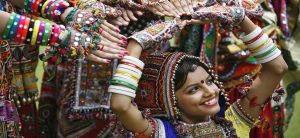Culture of coastal area of Gujarat, Tribal Culture
The total coastal length of Gujarat is about 1600 Km.Valsad, Navsari, Surat & Bharuch districts of Gujarat state have its western boundary as Arabian sea. It has been observed On western boundary of Valsad, Navsari, Surat, Bharuch & Jamnagar districts & on eastern boundary of Bhavnagar, Amreli, Junagadh, Porbandar & Jamnagar
districts there is coastal erosion. The erosion is taking place mostly under the action of strong tidal current accompanied by wave action. Particularly just before monsoon and in monsoon season. The shore line at these villages have been approached to habitable area, Local people of coastal villages are belonging to Machhimar community. The general situation of these villages is favourable from view point of fishing trade. Tendency of local people of coastal villages is not to leave their original place of dwelling near sea coast which facilitate their access to sea for fishing business and therefore, it is not possible to persuade local inhabitants to shift to the another place. Heavy damages are found to houses, fertile land and other property due to coastal erosion. Local people are representing for providing protective measures to prevent the Land ward recession of coastline.Gujarat is the home for five millions tribal communities who reside by the slopes of Aravalli’s, Vindhya’s western flank of Satpura and northern flanks of Sahyadri, encompassing parts of Vadodara, Surat, Sabarkantha, Broch, Banaskantha and Panchmahals. The major tribes of the region are Siddhi, Rabari, Bhils, Ahirs and Bharwads. Every sect has distinct origin, habits, habitats and cultural ethos.
Siddhi
The Siddhis are known to have migrated from East Africa and have distinct Negroid features. Various studies have revealed that these tribes are descendants Bantus of Africa and brought in India
as slaves by Portuguese and Arabic merchants.This tribal community earn their livelihood by forestry and animal hunting. Sidhi people are culturally enriched. Sidhis mainly eat vegetarian food on a daily basis. But during festivals and marriages, they prefer mutton locally called Akhni, Biryani, Fish and Paya. They are very fond of Pan and Supari.
Both men and women in Sidhi community wear frock, odhani or dupatta with heavy junk jewelries. They perform Dhamal dance and Goma songs in Africa’s Swahili language. After marriages, the tribal girl joins the clan with her husband.
Rabari
Rabri tribe have migrated from the Mediterranean region are mainly pastoralists. Rabari are found in the Kutch region. Rabari people are divided into 5 sub-groups called Debar, Gardo, Kantho, Katchi and Ragad.
Dairy is the primary form of living of Rabari people. They keep animals like sheep, cattle, goats, camels and buffaloes and extract and sell milk and ghee.
They are also renowned for a creative embroidery work. They eat vegetarian food and avoid alcohol except festivals and marriages. Rabari males wear turban and cotton white trousers while females wear jacket or open blouse, skirt, silver colored heavy jewelries and bangles in upper arms.
Bhils
The largest and most popular tribal community of Gujarat is the Bhils who live in parts of Surat, Bulsar, Banaskantha, Baroda, Dangs, Sabarkantha and Broach.
Anthropological studies reveal that Bhils were appointed by Rajputs as Shikharis because they have tremendous knowledge of the terrain. Locally Bhil means bowman as they are proficient in the use of bow and arrow.
Ahir
Ahir tribal communities have traveled from Sind and have settled in the Morvi and Kutch in Saurashtra of Gujarat. Ahir people mostly depending on cow herding and cultivation for their livelihood.
They are non-vegetarian and consume chicken, mutton, fish but avoid beef and pork. Wheat is their staple diet and occasionally eat rice. In winter, they also consume millets.
Bharwad
Bharwad tribe has drifted to Gujarat from Mathura in Uttar Pradesh and said to be followers of Lord Krishna. They are found in forested areas of Vadodara and peripheries of Gir forest of Junagarh district and mostly live by forest grazing. Bharwad males wear turban and cotton white trousers and woman wear backless top covered by veils and skirt along with heavy jewelleries. Their cloths are vibrant and mostly has designs of flowers, parrot and peacock. Bharwad tribe celebrate their annual Tarnetar fair along with Janmashthami and Navaratri. They eat non-vegetarian only on festivals and marraiges.
Final Destination for Kerala PSC Notes and Tests, Exclusive coverage of KPSC Prelims and Mains Syllabus, Dedicated Staff and guidence for KPSC Kerala PSC Notes brings Prelims and Mains programs for Kerala PSC Prelims and Kerala PSC Mains Exam preparation. Various Programs initiated by Kerala PSC Notes are as follows:-
- Kerala PSC Mains Tests and Notes Program 2025
- Kerala PSC Prelims Exam 2025- Test Series and Notes Program
- Kerala PSC Prelims and Mains Tests Series and Notes Program 2025
- Kerala PSC Detailed Complete Prelims Notes 2025
